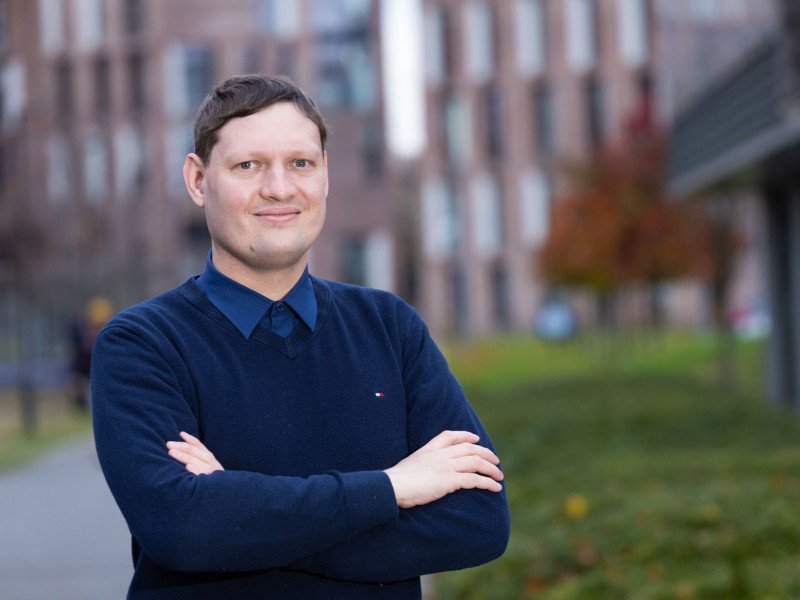
Maynooth University’s Dr Andrei Ermakov says that Ireland has ‘one of the best wave resources on the planet’. His research aims to use this untapped resource to fight the climate crisis.
Taking early inspiration from Jules Verne’s 1869 classic Twenty Thousand Leagues Under the Sea, Dr Andrei Ermakov completed a bachelor’s degree in marine engineering and applied mathematics and a master’s degree in mechanical engineering in St Petersburg. He travelled to the University of Southern Queensland in Australia to complete a PhD in fluid mechanics and the theory of water waves. In 2020, he joined the Centre for Ocean Energy Research (COER) at Maynooth University.
Unlike Verne’s underwater adventurer Captain Nemo, it is the surface of the ocean that most interests Ermakov. His SFI-IRC funded research project, MaxRotorWEC, is focused on developing a sustainable system to maximise the capture of wave energy to decarbonise Ireland’s energy grid.
Tell us about your current research.
The MaxRotorWEC project provides a new control strategy that can significantly improve the performance of cyclorotor-based wave energy devices, reducing costs, maximising energy produced and extending the device lifespan.
This new technology also has commercial applicability for cyclorotor-based wind and tidal turbines and propellers. The project will develop this technology, focusing on demonstrating its commercial viability as a competitive part of the renewables mix, strengthening Irish leadership in wave energy. I continue my work within COER, which is recognised as a leader in wave energy technology development, with more than 30 researchers working in this area.
In your opinion, why is your research important?
Wave energy is one of the few untapped sources of renewable energy that could make a significant contribution to the future energy system, and Ireland has one of the best wave resources on the planet with the potential to provide double Ireland’s electricity needs.
Unfortunately, to date, none of the more traditional prototypes which use buoyancy or diffraction wave forces have proven themselves to be commercially viable.
Recently conducted analytical and experimental assessments of the potential performance of cyclorotor wave energy converters (WECs) have shown that such devices offer the best wave absorption behaviour, if energy capture can be optimised through suitable control.
The further development of cyclorotor WECs could help to build a sustainable renewable energy system contributing to the decarbonisation of the economy. This development would not only improve renewable energy security but also enhance the overall energy supply, moving us closer to a greener and more sustainable future.
The success of such technologies is crucial in our ongoing efforts to combat climate change and reduce our reliance on fossil fuels, making significant strides towards a cleaner, more resilient energy landscape.
What inspired you to become a researcher?
When I was a child, I was inspired by Jules Verne’s Twenty Thousand Leagues Under the Sea. Since then, I have been fascinated by all things wave-related and combined that with an aptitude for mathematics and engineering. My mother was an associate professor in mathematics in Russia, and she inspired me to become a researcher.
What are some of the biggest challenges or misconceptions you face as a researcher in your field?
Explaining wave energy to people! Most people are familiar with wind turbines, but not wave energy devices. This is entirely understandable, since there are a vast number of different wave energy prototypes (more than 200) and very few have been deployed on a large scale, for people to see.
Wave energy faces a number of problems, many of which are common to other emerging technologies. These include the following: there is no design archetype and this can lead to investor confusion; several wave energy companies have folded, which makes potential investors skittish; the cost of energy produced is higher than that of more mature renewable energy technologies such as offshore wind – although the general consensus is that this cost of energy produced will reduce as the technology matures; and there are few demonstration models being tested at full-scale in the ocean – this leads to uncertainty for developers.
How do you encourage engagement with your work?
COER have created interactive wave tanks where the audience can make waves and see these waves creating energy. I also intend to produce a cyclorotor demonstration tank as part of this project.
I use events such as Science Week and transition-year-student visits to the university to encourage young people to consider studying STEM subjects and to get to know what might be a new type of renewable energy.
In addition to engagement with a non-academic audience, I believe strongly in the power of knowledge sharing, and will use the opportunity that the project affords to produce several journal papers and will attend a number of high-profile academic conferences. This project has funding for a PhD student, who will also be supported to produce academic publications.
10 things you need to know direct to your inbox every weekday. Sign up for the Daily Brief, Silicon Republic’s digest of essential sci-tech news.

